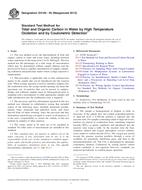Potřebujeme váš souhlas k využití jednotlivých dat, aby se vám mimo jiné mohly ukazovat informace týkající se vašich zájmů. Souhlas udělíte kliknutím na tlačítko „OK“.
ASTM D4129-05(2013)
Standard Test Method for Total and Organic Carbon in Water by High Temperature Oxidation and by Coulometric Detection
Automaticky přeložený název:
Standardní zkušební metoda pro Total a organického uhlíku ve vodě vysoké teplotě oxidace a detekcí coulometrickou
NORMA vydána dne 1.5.2013
Informace o normě:
Označení normy: ASTM D4129-05(2013)
Poznámka: NEPLATNÁ
Datum vydání normy: 1.5.2013
Kód zboží: NS-26152
Počet stran: 8
Přibližná hmotnost: 24 g (0.05 liber)
Země: Americká technická norma
Kategorie: Technické normy ASTM
Kategorie - podobné normy:
Anotace textu normy ASTM D4129-05(2013) :
Keywords:
carbon, carbon dioxide, high temperature oxidation, inorganic carbon, organic carbon, total carbon, ICS Number Code 13.060.50 (Examination of water for chemical substances)
Doplňující informace
| Significance and Use | ||||||||||||||
|
5.1 This test method is necessary because of the need for rapid reliable tests for carbonaceous material in waters and sediments. 5.2 It is used for determining the concentration of organic carbon in water that comes from a variety of natural, domestic, and industrial sources. Typically, these measurements are used to monitor organic pollutants in domestic and industrial waste water. 5.3 When a sample is homogenized so that particulate, immiscible phases, and dissolved carbon from both organic and inorganic sources is determined, the measurement is called total carbon (TC). When inorganic carbon response is eliminated by removing the dissolved CO2 prior to the analysis or the dissolved CO5.4 Homogenizing or sparging of a sample, or both, may cause loss of volatile organics, thus yielding a negative error. The extent and significance of such losses must be evaluated on an individual basis. If significant quantities of volatile carbonaceous materials are present or may be present in samples organic carbon should be determined by the difference between the total carbon and the inorganic carbon concentrations. When organic carbon determined both by difference and by sparging agree it is acceptable to determine organic carbon by sparging for similar samples. 5.5 The relationship of TOC to other water quality parameters such as COD and BOD is described in the literature.1.1 This test method covers the determination of total and organic carbon in water and waste water, including brackish waters and brines in the range from 2 to 20 000 mg/L. This test method has the advantages of a wide range of concentration which may be determined without sample dilution and the provision for boat or capillary introduction of samples containing sediments and particulate matter where syringe injection is inappropriate. 1.2 This procedure is applicable only to that carbonaceous matter in the sample that can be introduced into the reaction zone. When syringe injection is used to introduce samples into the combustion zone, the syringe needle opening size limits the maximum size of particles that can be present in samples. Sludge and sediment samples must be homogenized prior to sampling with a micropipetor or other appropriate sampler and ladle introduction into the combustion zone is required. 1.3 The precision and bias information reported in this test method was obtained in collaborative testing that included waters of the following types: distilled, deionized, potable, natural, brine, municipal and industrial waste, and water derived from oil shale retorting. Since the precision and bias information reported may not apply to waters of all matrices, it is the user's responsibility to ensure the validity of this test method on samples of other matrices. 1.4 The values stated in SI units are to be regarded as standard. No other units of measurement are included in this standard. 1.5 This standard does not
purport to address all of the safety concerns, if any, associated
with its use. It is the responsibility of the user of this standard
to establish appropriate safety and health practices and determine
the applicability of regulatory limitations prior to use.
Standard Test Methods for Total and
Dissolved Carbon Dioxide in Water Standard Terminology Relating to Water
(Includes all amendments and changes 2/14/2024). Standard Specification for Reagent
Water Standard Practice for Writing Quality
Control Specifications for Standard Test Methods for Organic
Constituents (Withdrawn 2002) Standard Practice for Intralaboratory
Quality Control Procedures and a Discussion on Reporting Low-Level
Data (Withdrawn 2002) Standard Guide for Management Systems in
Laboratories Engaged in Analysis of Water Standard Practices for Sampling Water
from Flowing Process Streams |
Odebírejte informace o nově vydaných normách ZDARMA:
Chcete pravidelně odebírat informace o nově vycházejících normách z celého světa a to zcela zdarma?
Přihlašte se k odběru. Vše je velice jednoduché a absolutně ZDARMA.
Na výběr máte vydavatele z celého světa.




 Cookies
Cookies
